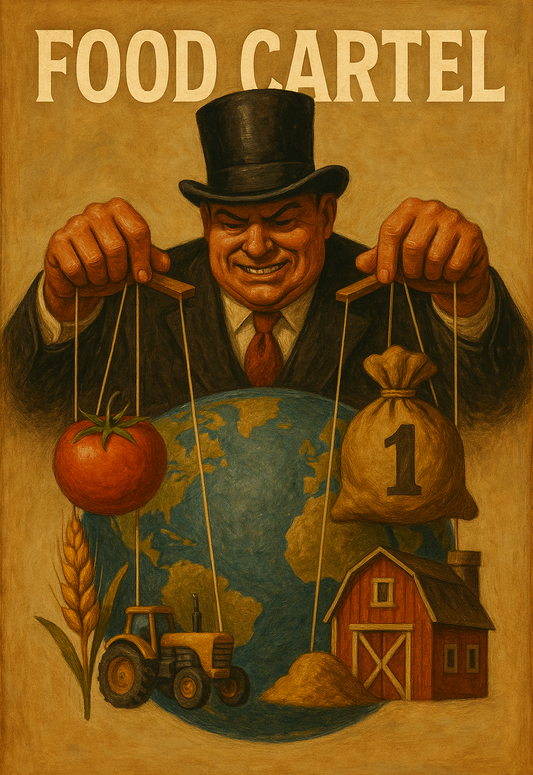The Food Cartel: How Mauritius Was Kept Hungry

In Mauritius, every bag of rice, every scoop of lentils, every bottle of oil is priced not only in rupees — but in deference. Our food economy runs on two ledgers: one that calculates cost, and one that conceals control. The island’s diet, once tied to land and season, is now chained to shipping lanes, procurement panels, and approved importers. The result is a quiet, sustained hunger — not always in calories, but in dignity, affordability, and national agency.
How dependency was designed — and then defended
After independence, the State Trading Corporation (STC) was built as a shield: centralise rice, flour, and petroleum procurement; smooth prices; protect households from global shocks. In the 1980s–90s, liberalisation arrived with promises of efficiency. New private “approved importers” were licensed. What began as protection and reform hardened, over decades, into concentration: a handful of firms, recurrently renewed licences, and tenders that seemed to know their winners before bids were written.
By the 2000s, five dominant food importers held the commanding heights. Relationships knit across decades — part family, part finance, part politics. The STC became both shield and gate. Price stabiliser on paper; price setter in practice. The logic was presented as prudence; the effect was power. Food, a necessity, became an instrument of economic structure.
Household Reality — Voices We Met
The quiet hunger of inflation and the weak rupee
Food inflation has outpaced wage growth for seven consecutive years. Official CPI underplays the bite; markets and meals do not. Fresh vegetables quietly give way to frozen. Branded staples are swapped for generics. Portion sizes shrink. The rupee does not only weaken against the dollar — it weakens against hunger itself.
Household Food Spend — Comparative Burden
Gatekeeping by commodity
Rice & Flour — stabiliser turned choke point
Rice and flour were placed under STC stewardship to stabilise supply. Yet discretion — in timing, in supplier choice, in premiums justified by “volatility” — has created space for bureaucratic mark-ups and tender choreography. Invoices from small bakeries show flour costs rising locally even as dollar wheat benchmarks softened. The carriage is ours; the horse is elsewhere.
Pulses — India’s bans, Mauritius’ blind spot
India’s export bans on lentils and chickpeas (2023–24) ripped through Mauritian markets. Prices spiked, shelves thinned. The rational response was diversification. Kazakhstan — with hundreds of thousands of tons in surplus red lentils — repeatedly offered supply at prices 20–25% below Indian equivalents. “Logistics,” said officials. “Gatekeeping,” replied traders. Access to alternative supply is access to alternative margins. Margin is territory; territory is defended.
Pulses — Missed Price & Stability
Edible oils — quality and yield ignored
Local refineries habitually source Argentine soybean and Malaysian palm. Contracts are familiar; donors familiar too. Kazakhstan’s sunflower oil, with lower free fatty acid content and better refining yields, traded 10–12% under Mauritian landed equivalents across much of 2024–25. Yet in Port Louis the answer was déjà vu — the same suppliers, the same ships, the same premia. “It’s not that we can’t import from Central Asia,” an industry veteran told us. “It’s that the wrong people would profit if we did.”
Edible Oils — Locked to Legacy
Meat — licences as territory
Kazakhstan’s halal platform — 400+ certified plants exporting to 49 countries — aligns with Malaysian and Gulf standards. Mauritius’ halal demand (≈17% of the population) grows, yet supply remains anchored to South Africa and Australia at a premium. The barrier is not belief or taste; it is the import licence. As one regulator put it: “Control protein, control the plate. Control the plate, control the people.”
What “Licence Concentration” Looks Like
The scarcity model — not incompetence, strategy
Scarcity is profitable. Limit the alternatives, narrate risk, delay paperwork, question certifications, exaggerate logistics — and margins hold. The public is told that Central Asia is a gamble; the real gamble is to import 80% of national food through five middlemen, priced in foreign currency, with no Plan B when prices spike or ships stall.
Currency & Settlement — The INR Corridor
What the street already knows
Ask around, and the patterns are obvious. A Plaine Verte mother stretches rice with split peas, not by choice but by arithmetic. A Flacq shopkeeper watches brands shrink their bottles before raising their stickers. In Triolet, a baker shows 2022 versus 2025 invoices — up ~15% locally while dollar wheat fell. These are not anomalies; they are the texture of an economy where food is mediated by licence, where prices include a premium for permission.
Audit, diversify, de-monopolise — actionable fixes
There is nothing utopian here. Open competitive tenders with transparent criteria. Diversify suppliers to Central Asia and East Africa. Use the INR corridor for staples to dampen FX pass-through. Publish the full STC tender history and all legacy supply contracts. Institute cooling-off periods for officials moving to importer boards. Create a real-time import dashboard: ship origin, contract price, landed cost, markup, retail price — visible to the public.
Roadmap — 180 Days to Lower Prices
Call things by their name
This is not a story of unavoidable geography or freight rates. It is a story of permission. Who may import; who may profit; who may eat well. Mauritius is not merely food-dependent; Mauritius is food-captured. Until courage unmakes the capture — until licences are utilities, not fiefs — Mauritians will keep paying triple for dal, double for oil, and more than they should for flour milled not on the island, but in the offices of men who have never farmed a day in their lives.
Hunger, here, is not a crisis. It is a business model. And the cartel, for now, is winning.
Sources & Method

Add comment
Comments